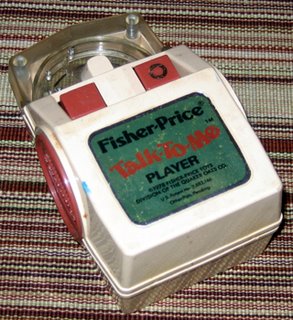
No, it's not a really old mouse.
This contraption, the Fisher-Price Talk-To-Me Player, is essentially a teeny-tiny upside-down record player.
It was used to play the not-coincidentally named Talk-To-Me Books, a collection of children's books that featured such stars as Mickey Mouse, Bugs Bunny and the Muppets.
You plunked the player on the part of the page that had a mini-record embossed on it. While technically a simple operation, those kids with less than stellar hand-eye coordination had a hard time lining it up properly.
I fondly remember the click-and-coiling-spring sound it made when you pressed the play button. Then the page would come to life, reading everything on the page.
It was a cool (but mildly time-consuming) way to listen to stories, especially for the kids who couldn't read yet.
Being a nerd, I had a hard time not reading ahead to the end of the page.
If you come across these books at a garage sale or thrift shop, odds are you'll catch #2: Disney's "Ghost Chasers," an adaptation of the 1937 cartoon "Lonesome Ghosts." That was the one that came with the player.
My brother and I gave ours to our cousins once we outgrew them. Thanks to my aunt, I reclaimed the books once my cousins had outgrown them and I had decided to archive my childhood.
I've had them in storage for the past few years, but now I'm thinking of cracking them open for my son so he can enjoy them before he gets old enough to openly mock technology from my youth.
When I looked these up on the Internet to find more information, I found this page on Wikipedia. The technology for this toy was developed by Reynold B. Johnson, who among other things, appears to be the reason we all had to use No. 2 pencils on our test forms.
But the article said he also brought us the disk drive and the videocassette, so I guess that makes up for it.
 Just because I'm a nerd, I took the player off the shelf and tested it on a Bugs Bunny book, "The Desert Island." Nada. Well that just wouldn't do, so I popped it open and MacGyvered it with (no kidding) a rubber band.
Just because I'm a nerd, I took the player off the shelf and tested it on a Bugs Bunny book, "The Desert Island." Nada. Well that just wouldn't do, so I popped it open and MacGyvered it with (no kidding) a rubber band.Granted, it didn't work well, but it played the record. Slowly. I hooked a mic into the computer, recorded the playback off the player's speaker and ran it through Audacity. Speeding it up about 15% seemed to do the trick. You can listen to the first page below.

